In this post, you learn about what is nuclear power plant how it works it layout and difference between nuclear fusion and fission and more.
Nuclear Power Plant
The cheap and abundant power is essential to the modern world in the coming years. The rapid increase in industry and living standard of the people creates pressure on conventional sources of power i.e., coal, oil and gas. It is now obvious that these sources will soon be unable to meet the increasing demands of the world.
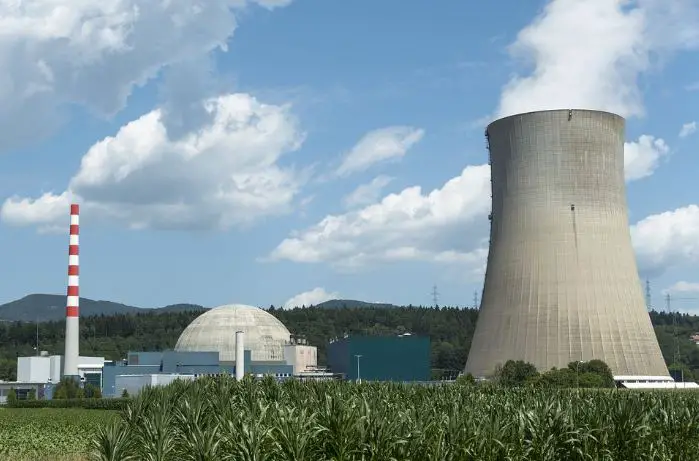
The adoption of nuclear energy for the generation of power is inevitable to the nations where other sources of generation are inadequate. One of the outstanding facts about nuclear power is a large amount of energy that can be released from a small mass of active material.
The complete fission of one kilogram of uranium contains energy equivalent to 3100 tons of coal or 1700 tons of oil. The nuclear power is not only available in abundance but it is cheaper than the power generated by conventional sources.
Read also:
- Power Plant: Types, Factors, Choices and Terminology Used in Power Plant
- What is Power Plant Economics? It’s Cost of Power Generation and Calculation
- Thermal Power Plant: Layout, Working, Elements, Advantages and More
Importance of Nuclear Power Plant
Despite the higher initial cost of a nuclear plant, the lower fuel cost permits conservation of foreign exchange in the power sector. A large amount of energy can be released from a small mass of active material i.e. the complete fission of one kilo of uranium includes energy equivalent to 3100 tons of coal or 1700 tons of oil. Nearly 1012 tonnes of uranium and thorium is available in the earth crust. The other factors which are in favour of nuclear energy are:
- Lower fuel cost.
- Upgrades the local industry through the use of cheap electric energy.
- Minimises the ecological effects of power generation.
- It does not require any fuel transportation facilities.
- It does not requires large storage facilities.
- Develops national scientific capabilities through national nuclear research developments.
- Improves the way of life and makes the people free from burdensome tasks which can be easily performed by electrical energy.
- It has no combustion products and it is a clean source of power which does not contribute to air pollution.
Nuclear Fuels used in Nuclear Power Plant
Following nuclear fuels are used in nuclear power plants:
- Natural uranium
- Enriched uranium
- Thorium
- Plutonium
- U233
- Uranium oxide (UO_2)
- Uranium carbide.
Nuclear Fusion and Nuclear Fission
Nuclear fusion and nuclear fission are different two types of reactions that release energy due to the presence of high-strength nuclear bonds between particles found within the nucleus. In fission, an atomic is split into two or more smaller, lighter atoms. In fusion, two or more smaller atoms fuse together, creating a large, heavier atom.
Nuclear Fusion
The nuclear fusion can be defined as the reaction in which the energy is released by means of combining two or more nuclei and forming a new element with a higher atomic number.
The energy released in fusion is related to,
E = mc2 (Einstein’s energy-mass equation)
Nuclear Fission
The nuclear fission can be defined as the reaction in which the energy is released by means of splitting of a massive nucleus into photons in the form of gamma rays, free neutrons and other subatomic particles.
The typical nuclear reaction involving 235U and neutron.

Followed by

Difference between Nuclear Fusion and Fission
| Nuclear Fission | Nuclear Fusion |
| 1. Fission is the splitting of a large atom into two or more smaller ones. | 1. Fusion is a fusing of two lighter atoms into a larger one. |
| 2. This reaction does not normally occur in nature. | 2. Fusion occurs in stars, such as Sun. |
| 3. Fission produces many highly radioactive particles. | 3. Few radioactive particles are produced by the fusion reaction. |
| 4. The critical mass of the substance and high-speed neutrons are required. | 4. High density, high-temperature environment is required. |
| 5. Lower energy is released. | 5. The energy released is 3 to 4 times greater than the energy released by fission. |
| 6. It is used in nuclear power plants. | 6. Used for bomb production. |
| 7. Uranium is the main fuel. | 7. Hydrogen isotopes are the main fuel. |
Components of Nuclear Reactor
A nuclear reactor is a device in which nuclear fission is controlled as a self-stabilizing chain reaction. In other words, it is a nuclear furnace which burns fuels like U235, U233 or Pu239 to produce the heat, neutrons and radio-isotopes as shown in the figure.
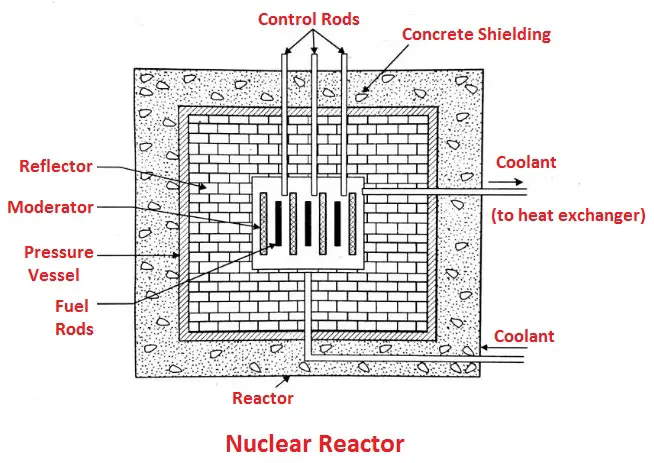
A nuclear reactor consists of the following:
- Fuel rod
- Moderator
- Reflector
- Coolant
- Control rods
- Shielding
- Reactor vessel.
1. Fuel Rod
The fuels used in reactors are uranium, plutonium and thorium. Among the three uranium and its content are naturally available up to 70% to 90% in the uranium ore and the other two are formed in the nuclear reactor during the fission process.
The fuel rods are used to produce the heat, neutrons and radio-isotopes.
2. Moderator
Its main function is to absorb the part of the kinetic energy of the neutrons. The neutrons collide directly with the moderator and thus reduces the kinetic energy of fast neutron to slow neutron. The light water, heavy water and graphite are the most common moderators used in reactors.
The moderator is also used to increase the probability of reaction.
3. Reflector
Its main function is to reflect back the escaping neutrons back into the core from the surface of the core. A reflector is usually placed around the core. The neutrons produced in fission process can be absorbed by the fuel itself, a moderator, coolant, and some neutrons may escape from the core without absorption. To reduce the loss of neutrons, the reflector is placed around the core.
4. Coolant
The main function of coolant is to absorb a large amount of heat produced in the reactor. The heat carried by the coolant is used for power generation. If water is used as a coolant, it absorbs the heat and gets converted into steam for power generation.
5. Control Rods
The control rods are used to :
- Start the reactor from the cold.
- For maintaining the chain reaction in a steady-state.
- To shut down the reactor automatically under emergency condition.
The control is necessary to prevent the melting of fuel rods and destruction of the reactor under emergency situation. Cadmium, boron or hafnium are commonly used as a control rod.
6. Shielding
A thermal shielding is provided through steel lining and external shield is be reactor installation to protect the operating provided with concrete surrounding the reactor installation to pro actor walls from radiation damage. personnel from exposure to radiations and reactor walls from radiation damage.
7. Reactor Vessel
It encloses the reactor core, reflector and shield. It also provides entrance and exit passage for coolant. The control rods are passed through a holder from the top of the vessel. The reactor vessel has to withstand a pressure of about 200 bar or more. The reactor core is placed at the bottom of the vessel.
Working of Nuclear Power Plant with Layout
The simple construction of a nuclear power plant as shown in the figure. It consists of a nuclear reactor, coolant circulating pump, heat exchanger, feed pump, condenser, turbine and generator as shown in the line diagram of the nuclear power plant.

The heat is generated in a reactor by the fission reaction. The coolant in the primary circuit gets heated by absorbing the heat and enters into the heat exchanger. In a heat exchanger, the feed water is heated and converted into steam by the hot coolant by means of heat transfer.
The steam from the heat exchanger enters the turbine and the turbine is connected to the generator which generates power. The steam after doing the work enters into the condenser and converted into the water which is pumped again to the heat exchanger by the feed pump.
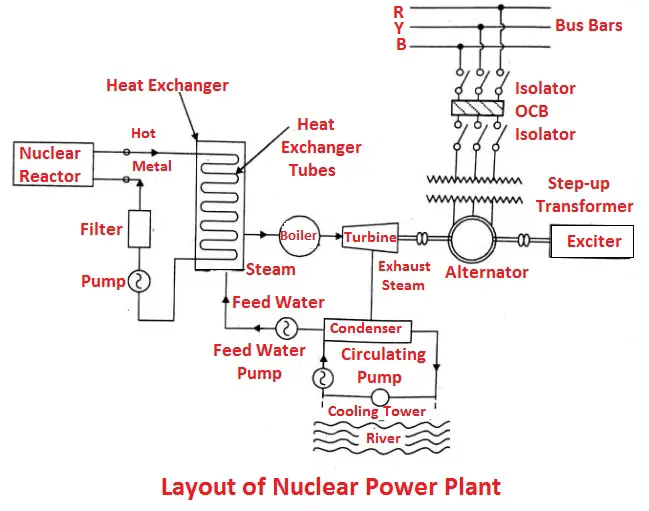
The hot coolant gets cooled in heat exchanger is recirculated into the reactor by a coolant circulating pump. This cycle is repeated for continuous generation of power. The generated power is supplied to the distribution line for consumers as shown in the line diagram.
Advantages
- Less fuel is required.
- It requires less space than thermal plant.,
- Compact and simple in maintenance.
- Less water is required.
- Transportation cost of the fuel is less.
- Low cost of erection.
- Fuel handling is negligible.
Disadvantages
- High capital investment.
- High maintenance cost.
- Radioactive wastes should be disposed of carefully.
- Skilled workers are required.
- It is not suitable for varying loads.
Types of Reactors
The reactors can be classified into the following categories:
- Depending on neutron energy:
- Fast reactors
- Thermal reactors or slow reactors
- Intermediate reactors.
- Types of fuel used:
- U235 reactors
- U238 reactor
- Th22 reactor
- Types of coolant used:
- Gas-cooled reactor
- Water-cooled reactor
- Liquid metal cooled reactor
- Type of moderator used:
- Graphite reactor
- Beryllium reactor
- Water reactor
- Type of core:
- Homogeneous reactor
- Heterogeneous reactor.
Thermal Fission Reactors
The various thermal fission reactors are:
- Pressurized water reactor.
- Boiling water reactor.
- Gas-cooled reactor.
1. Pressurized Water Reactor (PWR)
The arrangement of a pressurized water reactor is shown in the figure. In its simplest form, it is light water-cooled and moderated reactor. It uses enriched uranium as a fuel.
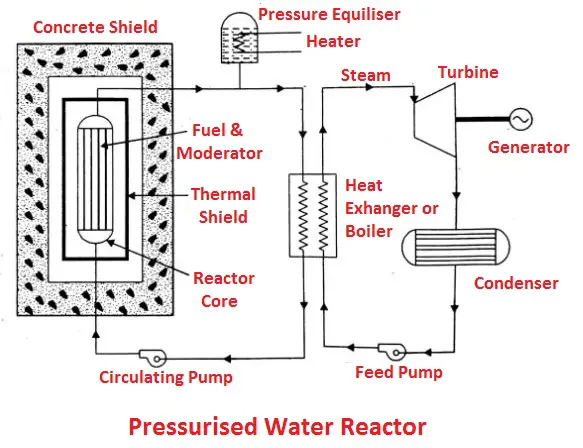
The pressurising tank in the circuit keeps the water at about 100 kgf/cm. So that it will not boil and picks up the maximum heat in the reactor. The electric heating coil in the pressurised boils the water to form the steam which is in the dome and pressurises the coolant circuit before starting the reactor. To reduce the pressure, the water spray is used to condense the steam.
The water in the primary circuit gets heated by absorbing the fission and the reactor core and same energy are given in the heat exchanger to generate the steam of feed water. The water coming out of the heat exchanger is recirculated by the pump to maintain the pressure in the circuit in the range of 100 to 130 bar.
The steam from the heat exchanger is supplied to the turbine to generate power. The steam from the turbine goes to the condenser where it is converted into the water which is pumped once again to the heat exchanger.
Advantages
- Water is used as a coolant, moderator and reflector, hence its operation cost is less.
- It requires a small number of control rods.
- Due to separate circuit, there is no radioactive contamination in the steam.
2. Boiling Water Reactor (BWR)
In this type of reactor, enriched uranium is used as a fuel and water is used as a coolant, moderator and reflector. In this case, the steam is generated in the reactor itself instead of a separate steam boiler as shown in the figure.
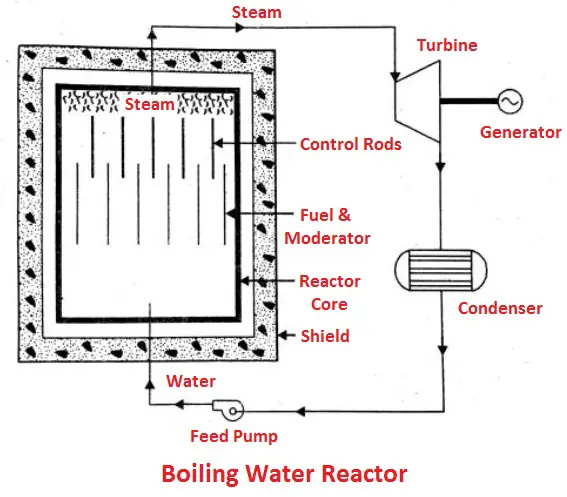
The steam produced in the reactor is directly used to run the turbine to generate power. The steam from the turbine is condensed back to water and is recirculated into the reactor by means of a feed pump, which is reheated and converted into steam in a reactor.
Advantages
- Heat exchanger circuit is eliminated, therefore the cost is reduced.
- Increased thermal efficiency.
- Low pressure in the vessel makes it much lighter.
- BWR is more efficient than PWR.
Effects of Nuclear Radiation
Following are the effects of nuclear radiation when it exposed to the atmosphere:
- Radioactive may kill all living organisms within an area of about 100 square miles.
- It affects human health such as –
- Reduction in resistance to infection.
- Vomiting, diarrhoea, fatigue, affects teeth.
- Damage the brain cells, cancer, damage Kidneys and lungs.
- Thyroid problem.
- Affects the blood system, weakens bones.
- Cause heart failure etc.
- Disruption of the ecosystem.
- Damage to the plants and animals, soil and wildlife.
- Water contamination.
- Risk of fumes and gases entering into the atmosphere.
- Damage the ozone layer.
Nuclear Waste Disposal
An international atomic energy agency recognizes four main classes of nuclear waste. These are:
- Low-level of nuclear waste.
- Medium-level of nuclear waste.
- High-level of nuclear waste.
- Uranium mine and mill waste.
1. Low-Level Waste and its Disposal
Low-level wastes include substances that have been contaminated with radioactive material or become radioactive by exposure to neutron radiation.
This waste typically consists of
- Contaminated protective shoe covers and clothing
- Wiping rags
- Mops
- Filters
- Reactor water treatment residues
- Equipment and tools
- Luminous dias
- Medical tubes
- Swabs
- Injection needles
- Syringes etc.
Disposal
The low-level wastes are disposed of inland file sites. This is the cheapest method of disposal because soil absorbs radioactive material easily. Such disposal is permissible in areas of low rainfall and is high above the groundwater level.
Most of the radioactive news of waste is removed just by storage. The problem of storage is simplified by separating caesium and strontium which are extremely radioactive. These are generally stored in tanks which are buried in the ground and then disposed of into the sea after 13 years of storage.
Many lines vacated coal mines are used for waste disposal. The wastes are disposed of in the salt heaps provided in the mines because salt is a powerful absorber of radioactive emissions and liquid wastes are disposed of by freezing.
Generally, radioactive gases (these are also low-level radioactive waste) are collected and stored in a tank buried in the ground and disposed of to the atmosphere when activity level is sufficiently low.
2. Medium Level Radioactive Waste
Waste that has been exposed to alpha (A) radiations, or which includes long-lived radio nucleoids in concentrations that require isolation and containment for periods beyond several hundred years is classified as medium-level radioactive waste. This waste requires shielding during handling and interim storage. These contain the reactor core components, resins, and filters used to purify the reactor’s water system.
Disposal
These wastes can also be disposed of the same method as that of used for low-level radioactive waste disposal.
3. High-Level Radioactive Waste
High-level radioactive wastes are used for nuclear fuel. When used fuel bundles are removed from the reactor, they are highly radioactive, contain long-lived radioactive and generate significant heat. This requires careful management over a very long period.
Disposal
For high-level radioactive waste, the geological disposal on land is the most appropriate means for isolating such wastes permanently from men’s environment. However, they can also be disposed in geological formations under the deep ocean floor, disposal in glaciated areas, extraterrestrial disposal and destruction by nuclear transmutation.
Various Methods involved in Disposing of Nuclear Waste
Following are most of the different possible methods of treating the disposal of nuclear waste:
- Deep geological repository
- Dry cask storage
- Ducrete
- Ocean floor disposal
- Saltcrete
- Spent fuel pool
- Spent nuclear fuel shipping cask (transportation)
- Synroc
- Waste isolation pilot plant
- Deep borehole disposal
- Vitrification
- Reprocessing
- Space disposal
- Transmutation
- Geological disposal
- Reprocessing
Advantages of Nuclear Power Plant
Following are the advantages of nuclear power plant:
- It requires less space compared to other plants.
- Well suited for large demands.
- It gives better performance at high load factors (80 to 90%).
- Less fuel consumption and no fuel handling.
- Transportation cost of the fuel is very less.
- Increased reliability of operation.
- These are not affected by adverse weather conditions.
- Less water is required.
- The higher capacity of the plant can be installed.
- Compact and simple in maintenance.
Disadvantages of Nuclear Power Plant
Following are the disadvantages of nuclear power plant:
- High initial cost.
- The danger of radioactivity hazards is always persisting.
- Not suitable for varying load conditions.
- The disposal of fission products is a big problem.
- The maintenance cost is always high.
- Skilled operators are required.
- Working condition is always detrimental to the health of the workers.
That’s it, thanks for reading. If you have any questions about “Nuclear Power Plant” tell us in the comments. If you like this article please share with your friends.
Read Next: